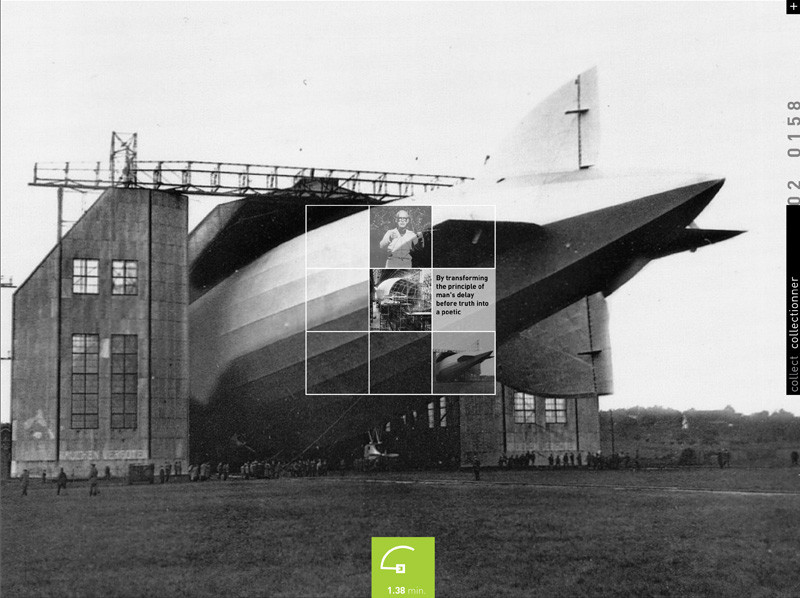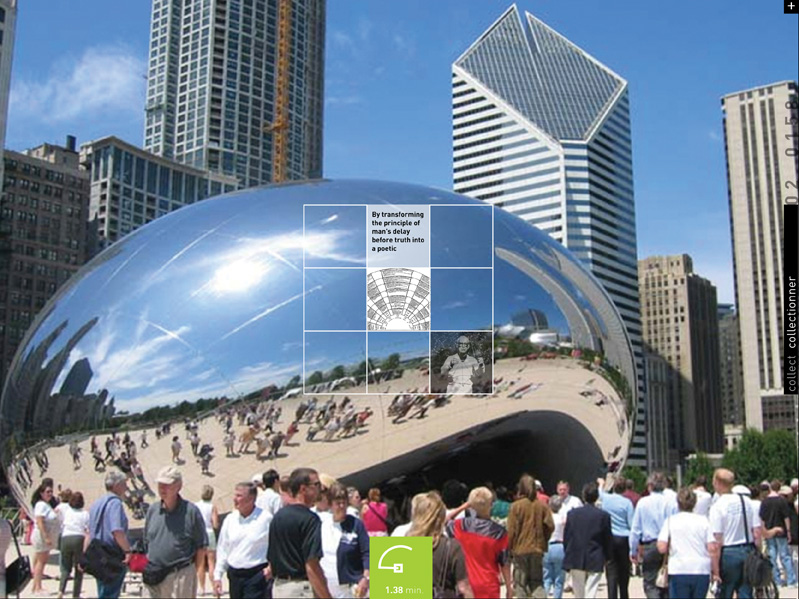[Fall 2008]
by Jacques Doyon
Jacques Doyon : Over the course of a photographic practice spanning more than twenty years, you have shown consistent interest in the archival aspects of images and the architecture of their storage and display. You’ve also produced artist’s books and installations reflecting on museum practices.
In 2000, you organized an important collection of images, news clippings, excerpts from a wide range of texts and films, and models of experimental archival works for the Reading Room for the Working Artist, 2003/2004, an installation of twelve artist’s books, a film projection, and furnishings designed after the model of Alexandr Rodchenko’s 1925 Reading Room for the USSR Workers’ Club. The work not only offered insight into your own working process but reflected on artistic practice itself as a form of idea exchange or play. You’ve recently completed an online work entitled Work + Play that builds on the materials found in the Reading Room with a trove of new documents accumulated since 2000. The new work, produced by Vox, centre de l’image contemporaine, will be launched in October.
Can you talk about what motivated you to remake the Reading Room into an Internet artwork, about the process involved in the transformation, and about the artwork itself?
Angela Grauerholz : When Marie-Josée Jean from Vox approached me about transferring Reading Room to the Internet, it seemed a logical extension of the work, and at the same time it offered the opportunity to compare the mediums of the book and the Internet, something that had preoccupied me, although peripherally, in my capacity as a teacher of typography and graphic design.
In thinking about the relationship between the two media and the possibilities of translating the installation into an Internet artwork, it occurred to me that encounters with both book and Internet involve similarly dynamic forms of cognition, although each engages you differently. Ironically, the movement involved in the book experience is more virtual; the book inspires a psychological journey – an imaginative linking of images and texts, experience and language – whereas the Internet entails actual, physical navigation. While there is a more embodied experience in traversing the architecture of an Internet site than in reading a book, you are not as psychologically engaged. My intention was to recuperate a sensual experience, as you would have with an artwork in real time and space.
Although the idea of the Internet as an architectural structure is not new, just as the Reading Room was not a novel concept, I knew that I wanted the Internet work to describe thought and creative processes spatially, and as I began to think about space and creativity and the relationship between movements of the mind and artistic production, the mnemonic system of the “memory palace” or “method of loci” came to mind. The system was used by scholars in antiquity as a memory prompt; a “memory palace” was built by associating each of a speech’s parts to a room in a building or public site and memorized by repeatedly travelling through the space. Later, the lecture (speech and reading) would be remembered upon the imaginary navigation of the previously traversed site. The “memory palace” offered my project a conceptual and architectural foundation. In effect, the final work, an interactive, Internet database, initiates and traces the movements of the participant’s thought processes through virtual space.
Work + Play is built around three components that correspond conceptually to the principal stages in the “memory palace” system: movement, spatial recognition, and what might be called a form of discursive production. At different levels, and in different ways, each component serves as an interface with a database of texts, images, sounds, and video. The first level encountered is represented by a long, seemingly endless film loop (like a perpetual motion machine) that the viewer “interrupts” in order to enter the work. The point at which the viewer stops the flow of the film also marks a concrete point of entry determining the nature and course of future movement. As the film slows, an opening appears between the film’s frames to reveal images of fields of knowledge, represented by rooms or architectural structures. These fields, named by activity, such as thinking, collecting, and constructing, serve as portals to thematically related data, which, in turn, are hyperlinked to other, associated items and terms. As the viewer browses, arbitrary selections are made from the different inventories of objects, images, and texts, and the viewer leads and is led through different – and at times surprising – circuits of signification. The selections are varied and the meanings of juxtapositions are provisional. This corresponds to the navigational activity: false starts and fitful moving, arbitrary tangents, crossovers, and superimpositions. Each investigation is recorded and mapped to permit the “player” to visualize and “remember” his or her visit to the site, and at the end he or she is rewarded.
JD : Is Work + Play a reinterpretation of the Reading Room?
AG : Yes, in the sense of having another look at the content of the earlier work, evaluating the different kinds of documents and envisioning their possible presentation keeping in mind this notion of linked and traversable rooms and spaces. In this way, the work doesn’t change the basic intention or meaning of the project. For the most part, the themes correspond to those in the earlier work, but they are articulated differently, and many more have been added. Work + Play is also still primarily interested in the role of memory and history in artistic and creative practices – the social aspects of art – however, it focuses quite a bit more on spatial modes of cognition and recollection.
Although the Reading Room was certainly concerned with the built environment– the installation and furnishings of the room were built “after” those in Rodchenko’s room and were conceived as a key part of the reading experience – the room itself functioned principally as an allegory for the worldview of the artist, or even the reader. The spatial concerns in Work + Play are not more literal but perhaps more integral to the function and dynamic of the work. They’ve also allowed me to refocus and expand my long-term exploration of what might be called the imaginary vitality of archives and storage spaces into the realm of space, more broadly speaking.
JD : You are talking about the furnishings that you designed for earlier installations as self-referential supports for the photography: the transparent storage drawers of Eglogue or Filling the Landscape (1995) and the mausoleum-like display cases of Sententia (1999). How does the Internet support compare to the structures built for these other works?
AG : Besides being virtual, the most obvious difference is that Work + Play makes reference to larger structures, most explicitly architecture. In considering the shape of my “memory palace,” I started to look at different architectural prototypes that I could use as models for the work – the transparency of Koolhaas’s Seattle Library, the “porosity” in Steven Holl’s work, and the modular design of Safdie’s Habitat offered interesting possibilities for thinking about transferring a sited exhibition to an non-physical space while maintaining the important sense of the exhibition experience as simultaneously directed and open-ended. In the end I opted for a modular design; I was particularly enthusiastic about Le Corbusier’s “Domino” system because of its commonality with the broadsheet, which is the book’s basic structural element. In the “Domino” system, interior and exterior elements are developed separately; the interior can be changed or modified to suit almost any exterior’s needs. Similarly, the broadsheet represents the internal structure of a book. More importantly, on a conceptual level, the modular structure and the broadsheet are made of individual, interchangeable parts, like cells. The notion of the cell interested me because it contained the idea of multiplication, community, growth, and also, analogously, the archive and the Internet. It also connotes the “singular” element of a larger system, separate but interconnected with the whole, and so corresponds in some basic way with the utopian aspect of Rodchenko’s thinking when he conceived the original Reading Room.
JD : To what extent does the Rodchenko reference persist in Work + Play? Does it also summon the modernist values of the Constructivist project – vanguardism, education, austerity, and functionality of design?
AG : It’s no longer the primary reference, but it certainly persists in shaping the conceptual logic of the work. Rodchenko’s Worker’s Reading Room represents an unrealized model for modern living that attempted to integrate study and creativity into social life. My Reading Room for the Working Artist was a model for artistic practice that insisted on the inherent sociality of creative production. The reference to Rodchenko was also meant to root contemporary artistic ideologies within this unrealized – and perhaps unrealizable – modernist template. There’s clearly a utopian dimension to Work + Play in the sense that I’ve outlined above, and an educational prerogative, and I would hope that the design is functional!
JD : What does the title Work and Play refer to? The nature of artist’s work? The artist at work in the Reading Room? A condensed description of human activity? Or a warning to the viewer of the nature of the engagement necessary to enter into work?
AG : Yes to all of these interpretations. Of course, more simply, the title of the piece refers back to the function of the Reading Room in Rodchenko’s design. He imagined the Worker’s Reading Room as a site of study and leisure, strategy and games – for work and play. It seems an apt characterization of the twinned poles of on-line experience too, doesn’t it?
JD : The Reading Room for the Working Artist was structured by the categories of materials organizing your personal archive. Each addresses a very different subject – circles, portraits of artists at play, epiphytes, water, walking, and so on – making a patchwork of themes without any apparent hierarchy. In this regard, the surreal logic of Borges’s Chinese encyclopedia comes to mind. The titles of the Reading Room book list return in Work + Play. How did you arrive at these themes initially? Did they emerge organically out of the collection, or were they defined before you started? Was there an original structure to your personal archive before you put it in play as an artwork? Or, has the fashioning of themes been part of the process of collecting?
AG : In the original collection that served as the basis for the Reading Room project, the themes emerged organically out of material that I found interesting and kept at hand. On one level, the archive is organized quite literally. Pictures and texts about water are kept together under that heading. So are materials about libraries and reading rooms, museums, and cemeteries and memorial sites. One of the intentions of the Reading Room was to make the creative process in art production transparent; the content referred to the influences and inspirations in my own practice. In this sense, the themes are as eclectic as my interests and my experience of the world but also specific to the interests that guide my practice at any particular time. I’ve always worked self-reflexively, so the materials that I’ve collected echo my thinking about photographic practice – so representations and reflections on death, museums, and so on take form as obvious groupings. To a certain extent, the categories still unfold organically, in relation to my current interests and practice, so I now search out content that references architecture, environments, places of work and leisure. All in all we are talking now about around 4,500 images (photographs, postcards, documentation, etc.) and texts (quotes, literary and theoretical texts, poetry, etc.)
JD : What kinds of collaboration has been involved in the production?
AG : From the beginning, when I started organizing my personal collection to the programming of the Web site, many people have helped me scanning, organizing, identifying, translating, researching, editing, and designing, including architects, Web designers, art historians, student assistants, colleagues, friends and family, and, of course, everybody at Vox, and all the artists whose works have inspired and influenced me.






